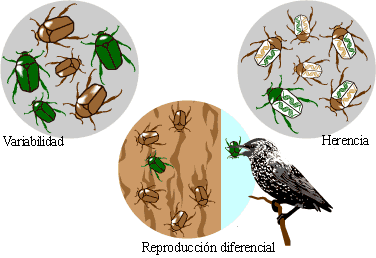The dynamics of a population depends upon births of new individuals and death of members of previous generations. This process is possibly accompanied by mutationssee below, but even without mutations, the frequency of an existing genesee below variant (allelesee below) in a population could still change. This is because some individuals produce more offsprings purely by chance. The process causing this random variation is known as Genetic drift. For example, when the number of individuals in a population is reduced drastically, the genetic diversity of the population will be extremely effected, even if certain phenotypes do not matter. This is called bottleneck effect. It seems that this random variation with no direction will lead to an unpredictable gene development. However, with statistical tools, we can actually describe the process and obtain some features.
In biology, a gene is a sequence of DNA or RNA which codes for a molecule that has a function.
An allele is a variant form of a given gene. Sometimes, different alleles can result in different observable phenotypic traits.
In biology, a mutation is the permanent alteration of the nucleotide sequence of the genome of an organism, virus, or extrachromosomal DNA.
wikiTo study the role of genetic drift, we perform simulation under a simple model. First a gene with two alleles is considered. We assume the population size does not change from generation to generation, and each allele has the same expectation of offsprings in the next generation. An assumption of no mutation is applied here to focus on the effect of genetic drift. An analogy with marbles in a jar with similar process can be found here. In zero-th generation, that is before any reproduction, all alleles are assumed to be in the same frequency. The video below shows the distribution of two alleles (red and blue) in each generation.
We can see after 19 generations, only red allele is maintained, and no blue allele can be found. Therefore, from here on no blue allele will show up if no mutation is introduced. We call this status as fixation (frequency of 100%) and loss (disappear) of alleles.
In this example, there are 20 individuals, and it is natural to imagine that when the population size becomes larger, the effect of drift will be smaller. To confirm this, we look at the allele frequency of the red allele in terms of generations under the population size of 20, 200 and 2000. For each configuration, 6 simulations are performed. The results shown below.

On the other hand, what if there are more than two alleles? To study the fixation time dependence on the number of alleles, we take a look at the distribution of five alleles in each generation which is shown in the video below.
We can see in this case, one allele is fixed after 34 generations, longer than 19 generations in two-allele case.

According to the two animations shown in the previous chapter, we see an interesting feature about genetic drift. With various allele number and (finite) population size, it will reach fixation / loss of alleles sooner or later. Therefore, the effect of genetic drift is reducing the diversity of gene. In the next chapter, we will see, a process with opposite effect happens in the real world, that is mutation.
Figure source: https://www.sesbe.org/evosite/evo101/IIIMechanisms.shtml.html